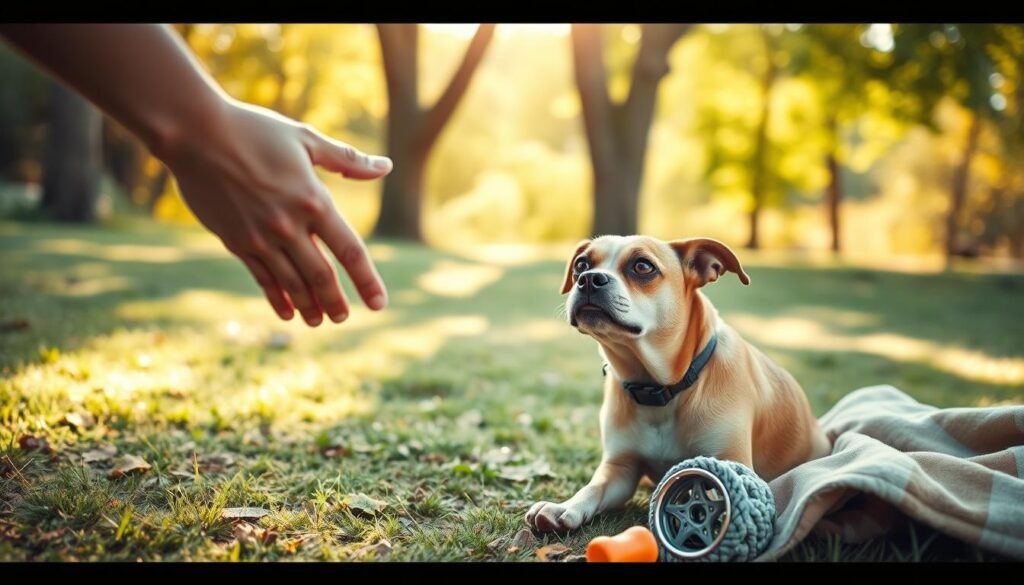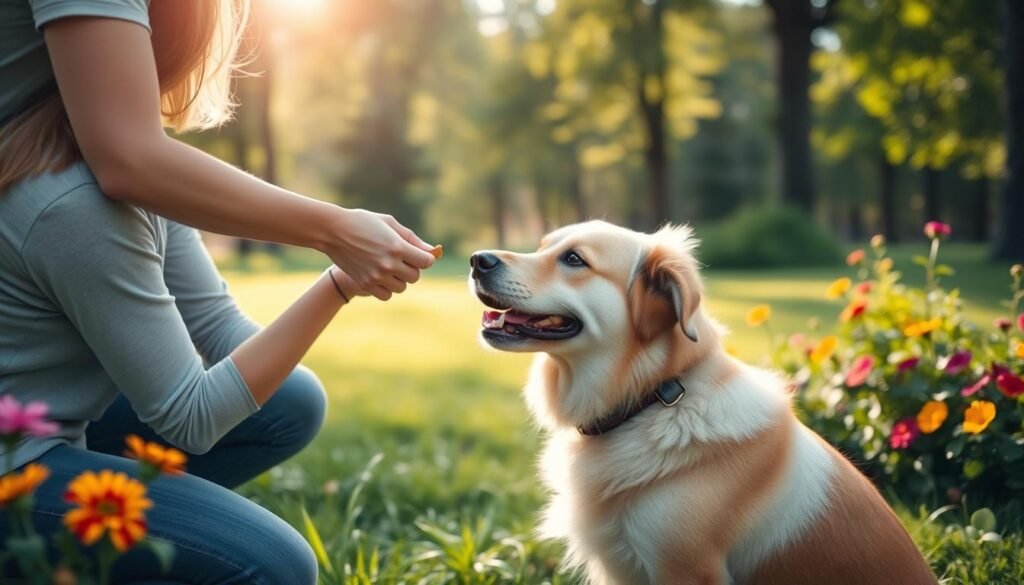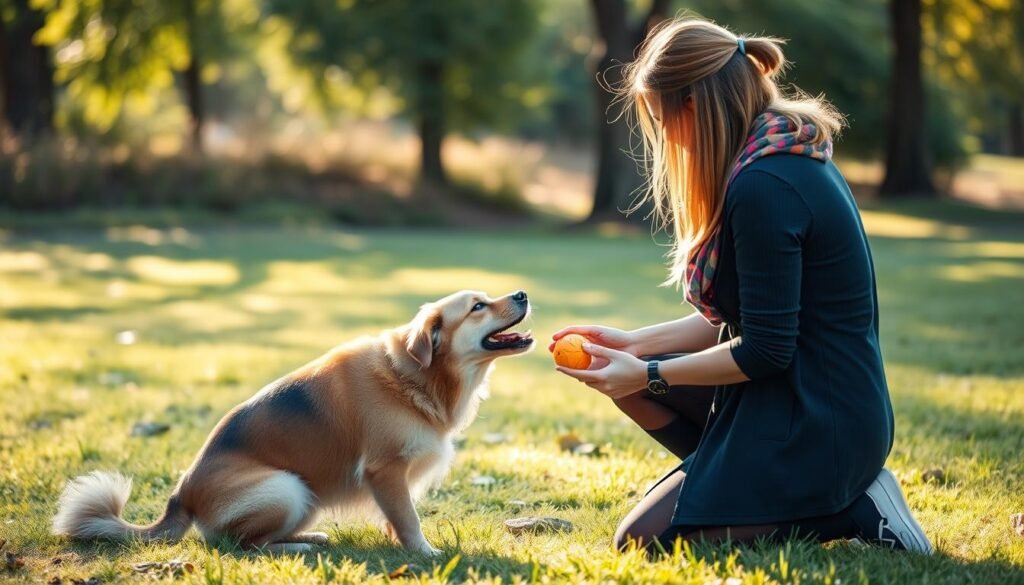Seeing your dog scared during training can be tough. You might wonder, why does my dog get so anxious during training? How can I make learning a safe space for them? Dog training anxiety is common and a big challenge for many owners.
It’s important to spot signs of stress like shaking, avoiding, or loud barking. This helps you adjust your training methods to help your dog feel better.
Figuring out what makes your dog anxious is the first step to solving the problem. This guide will show you how to find out what scares your dog and how to make them feel better. Whether your dog is a puppy or an adult, the goal is to create a safe and supportive place for them to learn.
Let’s find out how to turn your dog’s anxiety into confidence together.
Quick Recommendation. Our blog is filled with tips and tricks for training your puppy or dog. If you’re seeking a comprehensive online training program, we recommend K9 Training Institute.
Understanding Fear and Anxiety in Dogs
When your furry friend shows signs of distress, it’s important to understand why. Dog fear responses are not just random. They are complex and influenced by many factors. Knowing these can help you better meet your dog’s needs.

Many anxiety triggers in dogs come from their surroundings. Loud noises, new people, or changes in their home can cause fear. Genetics and past bad experiences also affect how they react to threats.
Knowing canine stress signals is crucial. Signs like barking, shaking, or avoiding can mean your dog is stressed. By recognizing these, you can reduce stress and make your dog feel safer.
Being patient and understanding is key. Each dog’s fear and anxiety are different. What helps one might not help another. Understanding your dog’s needs can make your relationship better and happier.
Initial Steps to Take for a Fearful or Anxious Dog
When you notice your dog is anxious or fearful during training, it’s key to act carefully. Start by creating a supportive environment. Understanding and patience are essential. So, how can you help your pet feel safe and comfortable?
First, make a safe spot in your home for your dog. It should be quiet and away from busy areas. Add their favorite bed, toys, and something with your scent for comfort. This spot helps your dog relax and feel calm.

Quick Recommendation. Our blog is filled with tips and tricks for training your puppy or dog. If you’re seeking a comprehensive online training program, we recommend K9 Training Institute.
To build trust, start with short, positive interactions. Use treats and soft words to make these moments pleasant. Keep these interactions predictable and routine to help your dog feel more secure.
Also, talk to a vet to check for any health issues that might cause anxiety. They can suggest ways to manage your dog’s anxiety. This ensures your approach is both safe and beneficial for your pet’s well-being.
Every step you take should aim to reduce anxiety and strengthen your bond. Managing dog anxiety takes time, but with patience and the right training, your dog will feel safer and more confident.
Positive Reinforcement Techniques
When you face challenges with a fearful or anxious dog, using positive training methods can make a big difference. Reward-based dog training is a powerful tool. It rewards your dog for calm behavior, not punishing them for being scared.
Begin by reinforcing calm behavior. This helps your dog link training to good experiences. Reward them right after they act calm in stressful situations. Doing this often builds a strong base and lowers anxiety.
Clicker training is a key part of reward-based training. It uses a click sound to tell your dog they did something right. This clear feedback boosts their confidence and makes them want to do it again.

Using these methods makes training fun for your dog. It also helps reduce their anxiety and fear. Being consistent with positive reinforcement techniques is crucial. It turns stressful training into a chance to bond and have fun.
Preventive Measures to Avoid Fear and Anxiety
To prevent anxiety in dogs, start early and focus on training without fear. This builds confidence and security. Socialization skills are key to preventing anxiety from starting.
Early socialization means introducing your dog to many people, pets, and places in a positive way. This helps them get used to the world and reduces fear. It’s about making a safe space for them to learn and explore.
Choosing the right training methods is also important. Use positive reinforcement to teach your dog without fear. This strengthens your bond and boosts their confidence and eagerness to learn.
Also, don’t put your dog in situations that might scare them until they’re ready. Gradually introducing them to new things is better than forcing them. Each positive experience helps build their confidence and reduces anxiety.

The aim is to create a loving and secure environment for your dog. With patience and understanding, you can build a trusting relationship. Stick to these strategies, and your dog will become a happy and well-adjusted companion.
Using Calming Aids and Tools
Using dog calming products can change the game for your dog’s training. These products are made to help your dog feel calm and relaxed. This makes training more fun and effective for both you and your pet.
The pressure wrap is a top pick for anti-anxiety dog tools. It applies gentle pressure to your dog’s body. This is like swaddling a baby, offering comfort and security. It’s key to introduce the pressure wrap in a calm place so your dog links it with feeling safe.
Calming scents and pheromones are also great. You can use diffusers, collars, and sprays to create a calm space. These are perfect for training sessions to lower stress and anxiety. Start using them a few days before any stressful events or training to get the best results.
Don’t forget about special toys as training aids for anxious dogs. Chew toys, for example, are very helpful. Chewing is natural for dogs and can help them relax. Having a special ‘anxiety relief toy’ can be very beneficial. It encourages good chewing habits and keeps your dog’s mind engaged during training.
Adding these tools to your training routine can gently and effectively tackle your dog’s anxiety. This leads to less stress and more success in training.
Common Mistakes to Avoid in Training
Training a dog with fear or anxiety requires avoiding common mistakes. Using negative reinforcement can actually make things worse. It can increase your dog’s stress and lower their confidence. Always watch for signs of discomfort and stop negative reinforcement right away.
Another mistake is mishandling dog anxiety reinforcement. Pet owners might unknowingly encourage fear by comforting their dog too much. For example, comforting a dog during a storm can make them fear storms more. Instead, offer comfort and distract them without making a big deal.
Don’t overwhelm your dog with too many things at once. This can make their anxiety worse. Training needs patience, especially with fear or anxiety. Keep sessions short, positive, and end on a high note to make your dog feel successful and secure.
Success Stories: Overcoming Fear and Anxiety
A rescue dog overcame extreme fear with patient training. At first, every noise or quick move made it hide. But with gentle training and support, it changed. It started to seek affection and play with other dogs.
A dog with severe storm anxiety was helped by its owner. They used desensitization techniques to overcome fear. Playing thunder sounds at higher volumes helped the dog learn to cope. Soon, it could handle storms without fear.
These stories show dogs’ resilience and the power of training. They prove that overcoming fear is possible. With the right approach, dogs can change and overcome their fears.
Conclusion
Starting to overcome dog training challenges means understanding your pet’s feelings. This article has shown important steps to help your dog feel safe and supported. Recognizing fear and anxiety signs and using positive reinforcement are key.
Being patient and consistent is crucial for a strong bond. This bond is the base for effective training. It helps your dog trust you more.
Preventive steps and calming aids can help your dog feel at ease. But, avoiding common training mistakes is also important. Sometimes, you might need a professional’s help.
If you’re not seeing progress, don’t worry. Getting help from a certified dog behavior expert is okay. They can guide you better.
Creating a well-adjusted dog takes effort, but it’s possible. By being informed and caring for your dog’s needs, you can overcome challenges. This will also strengthen your bond with your dog.
Quick Recommendation. Our blog is filled with tips and tricks for training your puppy or dog. If you’re seeking a comprehensive online training program, we recommend K9 Training Institute.

